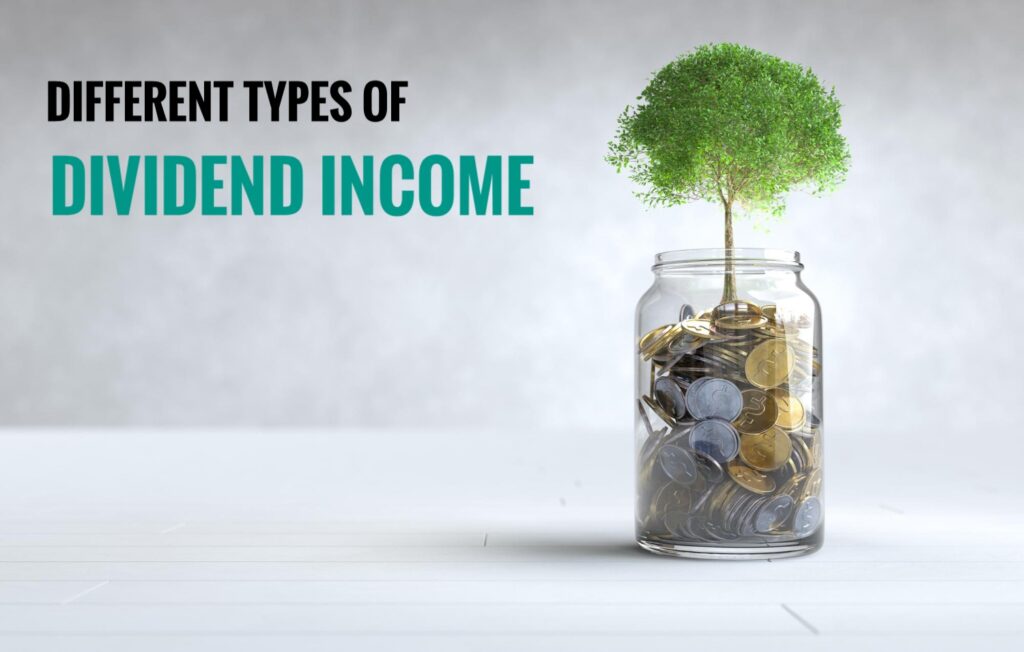
Table of Contents
Understanding the Different Types of Dividend Income: A Comprehensive Guide
When it comes to investing, dividend income offers an exciting opportunity to receive a portion of a company’s profits without having to sell your stocks. Dividends can come in various forms, each serving different purposes and suiting different types of investors. Understanding the different types of dividend income can help you better navigate your investment journey and make more informed financial decisions. In this article, we will dive deep into the various types of dividends and how they work.
1. Cash Dividends
Definition
The most common and widely known type of dividend income is the cash dividend. As the name implies, these dividends are paid in cash directly to shareholders, usually on a quarterly basis. The cash is deposited into the investor’s brokerage account or sent via check.
How Cash Dividends Work
Companies that are profitable and generate consistent earnings often distribute cash dividends as a way to reward shareholders. For example, if a company declares a Rs. 2 dividend per share and you own 100 shares, you would receive Rs. 200 in cash.
Benefits of Cash Dividends
– Liquidity: Cash dividends provide immediate funds that can be reinvested or used for personal expenses.
– Simplicity: Investors can easily track the amount of cash received without needing to monitor stock performance.
– Income generation: Cash dividends are a favorite among retirees and those seeking a steady income stream from their investments.
Drawbacks
– Taxation: Cash dividends are taxable, and investors must pay taxes based on their individual tax bracket.
– Reinvestment challenge: To grow your investment further, you’d need to manually reinvest the cash dividend, unlike other dividend types that may automatically reinvest into shares.
2. Stock Dividends
Definition
Instead of paying shareholders cash, some companies choose to issue additional shares of stock, known as a stock dividend. This allows investors to own more shares in the company without any immediate out-of-pocket cost. This is also one of the best ways in terms of dividend income.
How Stock Dividends Work
If a company declares a 10% stock dividend and you own 100 shares, you would receive 10 additional shares, bringing your total to 110 shares. These stock dividends increase your ownership in the company, though the overall value of your investment remains the same at the moment of issuance.
Benefits of Stock Dividends
– Tax efficiency: Stock dividends are not taxable at the time of issuance, allowing investors to delay tax payments until they sell the shares.
– Automatic reinvestment: Since stock dividends are given in the form of shares, they are automatically reinvested, compounding your investment over time.
– Ownership growth: Investors gradually build their stake in the company without spending more money to buy additional shares.
Drawbacks
– Market volatility: Although stock dividends increase the number of shares owned, the market value of those shares may fluctuate, and they may not yield immediate cash for personal use.
– Complexity: Calculating returns from stock dividends can be a bit more complex compared to cash dividends, as it involves monitoring share price changes and portfolio value.
3. Property Dividends
Definition
Property dividends are rare but still worth noting. In this type of dividend income , companies distribute non-cash assets—such as physical property, equipment, or even securities of other companies—instead of cash or stock.
How Property Dividends Work
For example, a company might distribute shares it holds in another company as a property dividend. These dividends are valued at the fair market price of the property being distributed at the time of issuance. This is one of the most popular dividend income source.
Benefits of Property Dividends
– Unique opportunities: Investors may receive valuable assets that could appreciate over time.
– Diversification: Property dividends, when distributed as securities from other companies, can help diversify an investor’s portfolio.
Drawbacks
– Valuation challenges: It can be difficult to assign an exact value to physical property or assets at the time of distribution.
– Illiquidity: Physical assets may not be easily sold or converted into cash, making them less liquid than traditional dividends.
4. Scrip Dividends
Definition
A scrip dividend is essentially a promissory note issued by a company to shareholders, offering the option to receive their dividend at a later date. Instead of paying an immediate dividend in cash, the company promises to pay shareholders at a future date, typically when cash flow improves.
How Scrip Dividends Work
If a company is experiencing temporary cash flow issues but still wants to reward shareholders, it might issue a scrip dividend. The shareholders may have the choice to receive their dividend in cash at a later date or convert the scrip into additional shares of stock.
Benefits of Scrip Dividends
– Flexibility: Shareholders can choose whether to wait for a cash payout or opt for more shares, depending on their financial goals.
– Company stability: Scrip dividends allow companies to preserve cash while still rewarding shareholders, helping them maintain stability during tough times.
Drawbacks
– Delayed payout: Investors looking for immediate income may be disappointed, as scrip dividends defer the cash payout.
– Uncertainty: If the company’s financial situation doesn’t improve, there could be a risk that the dividend will be delayed even further.
5. Liquidating Dividends
Definition
A liquidating dividend is a distribution made by a company to return part of the shareholders’ initial investment, rather than profits. This type of dividend typically occurs when a company is winding down or selling off assets.
How Liquidating Dividends Work
When a company is liquidating its operations or scaling back its business, it may choose to return capital to shareholders through a liquidating dividend. This differs from regular dividends, as it represents a partial return of the original investment, not earnings.
Benefits of Liquidating Dividends
– Return of capital: Shareholders can recoup a portion of their investment if the company is winding down.
– Reduced risk: By receiving a liquidating dividend, investors can mitigate losses as the company shuts down.
Drawbacks
– Limited growth potential: Once a company starts issuing liquidating dividends, it’s typically a sign that the company is no longer growing and may not offer future dividends.
– Uncertainty: Investors may face uncertainty about the amount they will receive, as it depends on the company’s liquidation value.
6. Special Dividends
Definition
A special dividend is a one-time distribution that companies issue to shareholders outside of their regular dividend schedule. These dividends are usually larger than regular dividends and are often paid after a particularly profitable period or the sale of a large asset.
How Special Dividends Work
When a company has an unusually successful financial year or makes a significant gain from selling part of its business, it may issue a special dividend as a way to share the excess profits with shareholders.
Benefits of Special Dividends
– Unexpected rewards: Special dividends are often seen as a bonus for shareholders, providing a higher-than-usual payout.
– Company confidence: Issuing a special dividend can signal that the company is in a strong financial position.
Drawbacks
– One-time payment: Since special dividends are not regular, investors shouldn’t rely on them as a consistent income stream.

How Much Can one make in 5 years with a small investment
Here’s an table showing how an initial investment of ₹50,000 can grow over 5 years with different annual dividend yields: 4%, 5%, 6%, 10%, and 20%, assuming dividends are reinvested annually. This does not factor in stock price appreciation.
| Annual Dividend Yield | Initial Investment (₹) | End of Year 1 (₹) | End of Year 2 (₹) | End of Year 3 (₹) | End of Year 4 (₹) | End of Year 5 (₹) |
| 4% Dividend Yield | ₹ 50,000 | ₹ 52,000 | ₹ 54,080 | ₹ 56,243 | ₹ 58,493 | ₹ 60,832 |
| 5% Dividend Yield | ₹ 50,000 | ₹ 52,500 | ₹ 55,125 | ₹ 57,881 | ₹ 60,775 | ₹ 63,814 |
| 6% Dividend Yield | ₹ 50,000 | ₹ 53,000 | ₹ 56,180 | ₹ 59,551 | ₹ 63,124 | ₹ 66,911 |
| 10% Dividend Yield | ₹ 50,000 | ₹ 55,000 | ₹ 60,500 | ₹ 66,550 | ₹ 73,205 | ₹ 80,525 |
| 20% Dividend Yield | ₹ 50,000 | ₹ 60,000 | ₹ 72,000 | ₹ 86,400 | ₹ 1,03,680 | ₹ 1,24,416 |
Explanation:
4% Dividend Yield: ₹50,000 grows to ₹60,832 after 5 years.
5% Dividend Yield: ₹50,000 grows to ₹63,814 after 5 years.
6% Dividend Yield: ₹50,000 grows to ₹66,911 after 5 years.
10% Dividend Yield: ₹50,000 grows to ₹80,525 after 5 years.
20% Dividend Yield: ₹50,000 grows to ₹124,416 after 5 years.
The table shows how higher dividend yields, especially with reinvestment, can dramatically increase the value of the investment over time due to compounding.
Conclusion
Dividendsare a valuable tool for investors, offering various ways to earn income from investments. Understanding the different types of dividend income—whether it’s cash, stock, property, or even a special one-time payout—can help you make more informed decisions and tailor your investment strategy to meet your financial goals. Each type of dividend has its own advantages and disadvantages, so consider your individual situation and long-term goals when deciding which dividend strategy works best for you.
